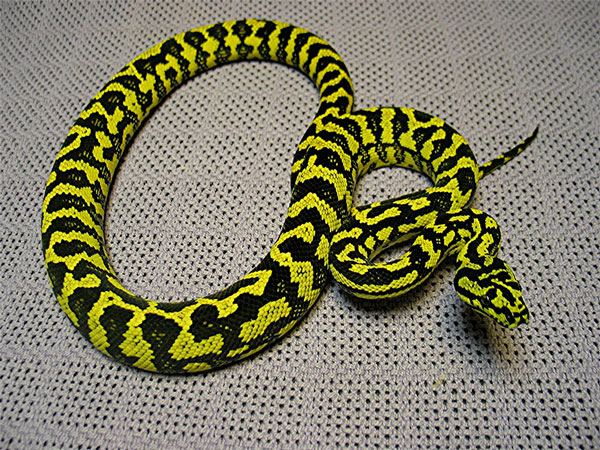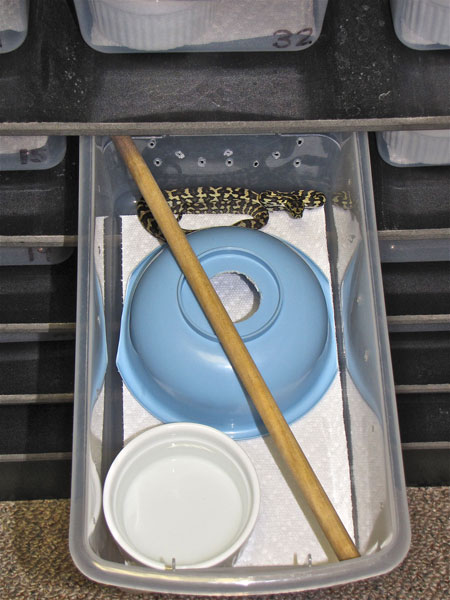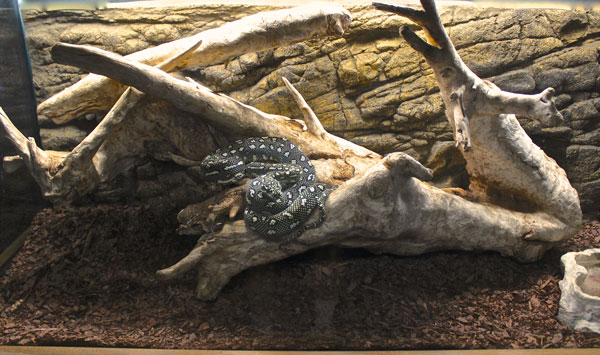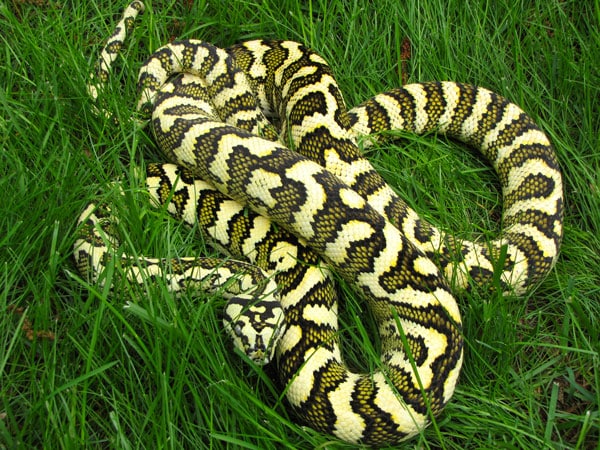Updated January 30, 2023 Care Sheet for the Carpet Python (Morelia spilotes) The carpet pythons are a diverse group of snakes from the Morelia g
Updated January 30, 2023
Care Sheet for the Carpet Python (Morelia spilotes)
The carpet pythons are a diverse group of snakes from the Morelia genus that are native to a wide variety of biotopes in Australia and New Guinea. They are called carpet pythons because they exhibit a dazzling array of patterns and colors that mimic the beautiful woven carpets found in the Middle East. Collectively they are considered a hardy, medium size python who thrive with keepers who prioritize reptile health & wellness. The more common carpet pythons available in the pet trade include jungle carpet pythons, diamond pythons, Irian Jaya pythons, and coastal carpet pythons. Selective breeding of carpet pythons has recently exploded with new “morphs” such as granite, caramel, jaguar and zebra carpet pythons.
Read More

JOHN BATTAGLIA
Jungle carpet python.
Carpet Python Availability
Carpet pythons are widely available in the USA and nearly all are captive bred. Almost every reptile show will have some carpet pythons for sale, and reptile classified sites on the internet have sections devoted solely for the sale of carpet pythons. Reptile specialty stores will usually have carpet pythons for sale and the larger chain pet stores sometimes have them. Range of price is as low as $75 to up to several thousand dollars for particular morphs (such as an albino zebra carpet python). Most carpet pythons are in the $200 to $300 range.
Carpet Python Size
Carpet pythons come out of the egg pencil sized, and once mature they range from 5 feet to 9 feet in length. On the smaller end of the size range are Irian Jaya pythons (mature about 5 feet) and upper end are adult coastal carpet pythons which are closer to 9 feet in length. Usually males and females are about the same size, although females are usually larger in diamond and coastal carpet pythons.
Carpet Python Life span
Carpet pythons in captivity can easily live 20 years or longer.
Carpet Python Caging
Caging for carpet pythons should allow for some retention of humidity, unrestricted observation of the snake, ample area for the snake to move and climb, and easy ability to clean. The reptile habitat should mimic naturalistic conditions with proper snake habitat products.
In years past aquariums were the staple of snake caging, just because they were pretty much the only thing available. Aquariums are not the best housing, however, because having a top entry to a snake cage makes handling difficult and can also cause stress to the snake as many natural predators to snakes are coming from above. In addition, the glass of aquariums can absorb heat over extended periods of time and cause an extensive build up of heat.
Thus aquariums used as terrariums for snakes can have problematic temperature regulation, especially for small sizes. Nowadays there are many good options for caging that are constructed of plastic, polyethylene or PVC and built specifically for snakes. A large number of shapes and sizes are available, but in general these cages have solid, opaque sides, top and bottom, with the front access door made of transparent material such as acrylic plastic or glass.
The door can open either sideways or top to bottom, and this allows easy handling of the snake as well as easy cleaning. Having opaque sides and top seem to offer some security for pythons, and this is especially important for hatchlings. In regard to size, the length of the snake should not be greater than the sum of the length plus width of the cage. Carpet pythons do not need a lot of height, but are semi-arboreal and prefer some climbing room. For this reason the cage should have at least a shelf they can climb onto or some cage furniture that is off the floor of the cage. Carpet pythons must have a hide box or similar furniture that allows them to completely and tightly crawl under and be hidden from view. Hatchling carpet pythons do best in smaller, shoebox size cages often in rack systems.

JOHN BATTAGLIA
Hatcling in a tub with water, a hide and a dowel for climbing.
Many carpet python owners have adult snakes in a 4’ long x 2’ deep x 1’ high cages. One foot of height is probably the minimal needed, because a hide box that is 5 inches high will still allow a space for the pythons to climb on top and have an arboreal perspective. A 3’ x 2’ x 2’ cage will suffice for smaller carpet pythons such as Irian Jaya and jungle carpet pythons. I have one large display cage (5’ x 3’ x 4’) in my home that I cycle my carpet pythons through periodically so they all have opportunities for exploration and exercise. I believe this helps combat cage stagnation and improves the overall health and breeding fitness of the python.
Carpet Python Lighting, Temperature, Humidity
Carpet pythons do not have any specific lighting requirements. Having some form of lighting for the cages will allow for better visualization of the snake and easier examination of the cage for cleaning. Full spectrum lighting such as Exo Terra Solar Glo All in One Reptile Lamp may be beneficial for breeding purposes such as seasonal light cycling, but is not necessary.
A temperature gradient should be provided within the cage so the snake can thermally regulate to either a cooler or warmer side of the cage. A gradient of 72 degrees F for the lower end up to 90 degrees F for the warmer end is optimal. Ceramic heat emitters or radiant heat panels can be mounted on the cage top, or flex-watt tape underneath may be used. The negative to using ceramic heat emitters is that they cause the air to dry out thus significantly lowering cage humidity. In my opinion radiant heat panels are preferable for larger enclosures, and should be temperature controlled using a thermostat or a rheostat. For practical reasons, flex watt tape or a heat pad mounted underneath is usually used for the smaller cages (rack style) or individual habitats.
Although carpet pythons are hardy and seem to thrive regardless of humidity level, I believe their health is better when there is decent humidity (around 50%) in the cage. This can be accomplished by using a water dish with large surface area in the cage, as well as by occasional misting of the habitat. Misting the cage more often when a carpet python is in ecdysis is beneficial. If misting is used, make certain to allow complete drying before the next misting, as otherwise the moist cage can become an environment for bacterial growth.
Carpet Python Substrate
Carpet pythons do well on a wide variety of substrates. Care must be taken to remove wet or damp newspapers and paper towels, as these can cause skin infections in the python. Aspen or cypress wood shavings are decent substrates and have the added benefits of looking more naturalistic as well as absorbing odors. I use a laboratory grade bleached hardwood pulp in many of my carpet python cages, and pine wood mulch in some of my naturalistic display cages.

JOHN BATTAGLIA
Naturalistic enclosure.
Carpet Python Food
Rats, rats, and more rats (frozen thawed) are the preferred food source for carpet pythons. Some carpet pythons that are started on a diet of mice as hatchlings develop a fussy preference for mice (“mousers”) and refuse to eat anything else. This is not a problem while the carpet python is small, but once it develops into a larger python it might require 10 mice at a time for a substantial meal.
There are a number of methods to convert mousers into rat eaters, the simplest being thawing a frozen small rat (slightly smaller than a mouse) in a zip lock bag along with a frozen mouse and adding a slight amount of water.
The picky carpet python will often accept such a mouse-scented rat without problem, eventually leading to eating rats without need for scenting measures. Chicks, quail and other rodents may be supplemented for the diet, but are not necessary.
Carpet Python Water
Fresh water must be available at all times for carpet pythons. Larger water dishes are preferable, because they both raise humidity and are less susceptible to bacterial growth. Water dishes should be changed and washed at least weekly, and more often if soiled by the python. Water from the tap may be used without problem.
Carpet Python Handling and Temperament
Carpet pythons are picked up much easier from below than above. Support the bulkiest part of the snake with one hand from below, and use your other hand to support forward from that point. Hatchlings up to one year of age are nippy and defensive, which makes sense as they are mostly prey in the wild at this age. After about a year or two most carpet pythons will settle down and are then relatively calm when handled.
John Battaglia has been a reptile enthusiast for over 40 years, and over the past decade has focused his efforts on the selective breeding of carpet pythons and more recently on carpet python – green tree python hybridization. Website: Morelia Trophy Club – moreliatrophyclub.com


